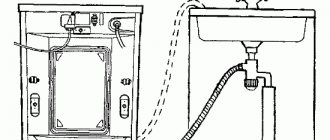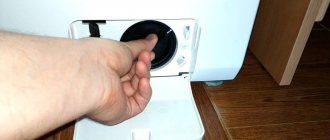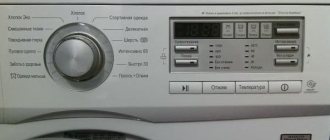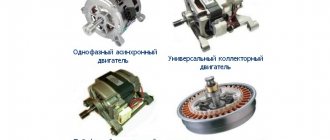What should you do if, after a certain period of proper operation, your machine or RCD in the electrical panel starts to trip when you turn on the washing machine?
Not everyone wants to immediately run to a service center, especially when the warranty has already expired. And transporting such large equipment is not an ordinary task.
In most cases, you can identify the breakdown and eliminate the cause yourself. The main thing is to know what to check and how.
Moreover, with a competent approach, it is possible to identify the cause of the shutdown even without special measuring instruments. There are several common symptoms and cases, let's look at them in order.
Damage in the wiring - the washing machine is not to blame
Where to start troubleshooting? Firstly, you don’t need to immediately climb in and disassemble the machine. Maybe it has nothing to do with it at all, but the socket, wiring or the machine itself is to blame.
How to find out? Connect a load of approximately the same power to the same outlet. For example, an electric kettle and see how the machine behaves.
If he knocks it out again, then the washing machine has nothing to do with it. You need to look for damage:
- in the socket
- in the wiring
- in a machine, RCD or panel
If nothing turns off, then most likely the machine is to blame. To make sure of this 100%, temporarily connect it from a portable outlet from another outlet that is not connected to the bathroom line.
True, several conditions must be met here:
- this should be a short-term option, just for testing
The SMA cannot be permanently connected through a carrier.
- such an extension cord must have grounding contacts
- the protection device of the other outlet must correspond to the rating of the bathroom line
- the plug must be installed in exactly the same way, that is, you need to guess the phase and zero
The fact is that if you turn the plug 180 degrees, the protection often stops triggering.
For a faulty washing machine, it turns out that there is a difference where the phase is supplied and where the zero is supplied.
Sometimes people “treat” their problems this way. Although the device cannot be turned on for a long time in this operating mode.
Only if all the above conditions are met, in the event of a malfunction of the washing machine itself, another machine or RCD will trip.
By the way, when you do not have a dedicated line to the bathroom, and there are other sockets on the same circuit breaker, before all manipulations and checks, be sure to turn off all extraneous loads.
Suddenly it turns out that the reason is not the washing machine at all, but other equipment connected in parallel.
So, if you find out that without the machine in the outlet, nothing turns off. We are looking for a leak or short circuit before it.
Turn off the machine, check that there is no voltage in the outlet and disassemble it for visual inspection.
It is very important that only waterproof sockets are used for washing machines in the bathroom. Otherwise, oxidation of the contacts and constant tripping of the RCD or automatic circuit breaker are guaranteed.
When opening a simple socket, all its contacts and the housing itself will be constantly wet. In this case, the RCD may spontaneously trip even at idle, when nothing is connected in the bathroom.
In order to somehow work with such an outlet, you will have to constantly keep the exhaust fan on in the bathroom.
Also, condensation often forms inside machines with a washing temperature of no more than 40 degrees. With this mode and when rinsing in cold water, droplets of moisture first settle on the inner walls and then reach the electrical contacts.
If there is damage in the outlet, you will definitely see it by soot and burnt contacts.
Well, if you don’t find anything suspicious here, then check the cable.
In a good way, this is done with a special device - a megohmmeter.
The ends on both sides of the cable are unscrewed and the insulation is caused.
The problem is that not even all electricians have such a measuring device at home. What can we say about ordinary consumers?
How can we manage without it? A modern home electrical panel in most apartments and private houses no longer consists of just two switching devices or plugs.
It contains at least ten switching devices, or even more.
All you need to check is to transfer the cable going to the outlet in the bathroom under the washing machine to another protective device of a similar rating.
To do this, for greater safety, turn off the common input and check that there is no voltage in the switchboard.
Next, unscrew the phase conductor from the terminal of the washing machine and transfer it to another protective device of the same rating.
Having first removed the original cable from it, which goes to another load. Turn on the input and the “new automatic” protection. Again, check everything by turning on the load in the form of a kettle in the bathroom.
Normal power circuit Test power circuit
If your other machine is knocked out, it means there is a defect in the wiring. You will have to check the entire chain, open all junction boxes, etc.
Read more about the steps of this check in the article below.
By the way, an RCD in such cases can often trip simply due to a weakened zero in the switchboard itself. You will run around the whole room, open the wallpaper, and the reason will be right under your nose. Don't rule out this option either.
If, after switching to the new device, everything works properly, then change the original switch. Most likely, the contacts in it have burnt out and it no longer holds its rated load.
Reasons for failure of temperature sensors
The main causes of thermostat failures are:
- Frequent washes at high temperatures. Such temperature conditions affect the rapid wear of many parts of washing machines, and also negatively affect the quality of the fabrics of the washed items. Modern detergents are quite effective in removing stains even at low washing temperatures;
- Unstable voltage in the power supply network. Voltage fluctuations have a detrimental effect on any electronic components, and short circuits instantly damage them. To use a washing machine, it is best to install a separate electrical wiring line from the meter of your home.
- The wires must have a sufficient cross-section to avoid overheating of the insulation. The device must be grounded. For your own safety, you need to install an RCD (residual current device).
- How is blood washed off?
- How to wash membrane clothes
Causes of failure in the washing machine
Now let's look at the reasons when the malfunction is related to the washing machine itself.
There are many more damage options here:
- short circuit or breakdown of heating element
- defective plug or cable in the machine itself
This is most often visible even visually. It is enough to carefully examine all contacts on both sides.
You won't be able to disassemble the fork; it comes cast. But the integrity of the insulation can be traced.
- engine damage (water entered due to leaky gaskets)
- faulty line filter or control board
You should always start your search with the most common breakdown - a malfunction of the heating element. In 2/3 of cases, it is because of this that the machine and the RCD are turned off.
Again, everything can be revealed without instruments. How to do it?
Installation
The heating element is installed in an LG washing machine as follows:
- Take a new TEN.
- Lubricate the seal with WD-40 or another type of lubricant.
- Install the part into the groove.
- If the heater goes in and sits tightly, you can tighten the fasteners and hook the wiring into place (remember that you took a photo!).
At this stage, replacing the heating element in the LG washing machine can be considered successfully completed. All you have to do is run a test wash to make sure the newly installed part is working properly.
Turn on the high-temperature mode and 15-20 minutes after starting the program, touch the glass of the hatch - if it is not cold, the heating element heats up.
This video will help you clearly understand how to remove the heating element from an LG washing machine:
And it doesn’t matter what kind of heating element is in the LG washing machine - if you don’t follow the rules of caring for the machine, it will burn out. Hard water and scale slowly but surely make parts unusable.
Install a filter and use softening agents, then your machine will last longer.
Checking the heating element in a washing machine without a multimeter
First of all, do not forget about safety precautions and before any work inside the machine, not only turn off the machine in the panel, but also pull out the power plug from the socket.
Next, remove the back or front cover (depending on the design) to get to the contacts of the heating element. The heating element will be located at the bottom.
The phase and neutral are suitable at the edges, and in the middle there is grounding.
When you don’t even have a multimeter at hand, to check the heating element, simply remove the phase and neutral conductors and insulate them.
Now plug the washing machine into the socket and turn on the machine. If the machine starts and the machine stops knocking out, then change the heating element.
It was he who caused the malfunction.
However, keep in mind that some SMAs do not work without a heating element. They have it connected in the same circuit with the water supply valve. In this case, unfortunately, there is no way to do without a tester.
With your own hands
Replacing the heater in a washing machine
The washing machine stopped heating the water when washing Electrolux dishwasher connection. The malfunction in 99% of cases lies in the failure of the heating element - the heating element. The cause of the breakdown is deposits of scale, dirt, etc. on the heating element, which causes heat transfer to deteriorate and the heating element coil to burn out. So, replacing the heater in the LG washing machine, as they say, the eyes are afraid, but the hands do it.
The heating element in an automatic washing machine must always be in water during operation, therefore it is installed at the back of the washing machine tank. To replace it you need:
Make sure that the washing machine is disconnected from the electrical network. Then remove the back cover of the machine by unscrewing 4 or more screws. The heating element is observed under the drum pulley (or under the electric motor in LG machines with direct drive).
For ease of operation, you can remove the drive belt. Next, remove three wires from the heating element terminals: two supply and one ground, plus a connector from the temperature sensor, if it is installed on the heating element.
Loosen the nut on the central screw of the heating element by 5-6 turns and push the screw inward to this distance.
Using two flat screwdrivers, pry up and remove the heating element. This operation will require little effort, because... the sealing rubber of the heating element can be strongly compressed when installing the heating element and the resulting rim will not allow the heating element to be immediately removed (typical of SMA Atlant). The layer of scale and other deposits that forms over time will make it difficult to replace the heating element in the washing machine. Remove the heating element from the washing machine body carefully so as not to damage the tank. Through the hole of the removed heating element, we remove the remaining scale, dirt, etc.
It is better to install a heating element from the same company as the one that was removed; in extreme cases, by comparing the sizes of the sealing rubber, we make sure that they are the same.
We install the new heating element in the reverse order - the heating element is tightly inserted into the tank, without missing the guide bracket inside the tank, and the nut of the central screw is tightened. You should not tighten the nut too hard; just tighten it until a slight resistance to clamping appears.
Place the belt on the electric motor and the drum pulley, turning the drum to make sure that the belt goes in the center of the pulley and the drum does not rub the installed heater (if you missed the guide when replacing the heating element).
Next, we connect the electrical wires and check everything again. We start the washing machine to check that the water is heating and there are no leaks. Please note that in some washing machines the heating is turned on only a few minutes after starting the washing program. In domestic conditions, it is convenient to control the activation of the heating element using an electric meter.
Close the back cover and put the car in place.
The process of replacing the heating element in front-facing washing machines is similar to that described above, only to access it you will have to disassemble the entire front part of the machine body.
Replacing heating element in a washing machine. the process of which is described above is not a guide to action - it is better to trust the repair of washing machines to specialists! In the next article we will tell you how to change the bearing in a washing machine.
Washing machine pump repair can be found here
Checking the heating element of a washing machine with a multimeter
If you still don’t trust all these experiments and want to be 100% sure that it is the heating element that is damaged and not something else, then your only assistant is a multimeter.
How to properly check the heating element? Again, pull out the plug from the socket, and put the tester in resistance measurement mode.
A measurement scale of up to 200 ohms will be sufficient.
Apply probes to the contacts of the heating element to check its integrity and absence of breakage. In a normal situation, its resistance should be in the range from 20 to 50 Ohms.
If the device shows infinity, then the spiral is broken.
You also need to test it for a short circuit to the body. Apply one probe to the metal part of the heating element or the central bolt where the grounding is located.
And with the others, you alternately touch the phase and neutral terminals.
Any values, even several tens of kiloOhms, indicate that the heating element is broken and must be replaced.
By the way, if there is a simple break in the heating element without shorting it to the housing, the machine will not knock out.
In this case, an error may appear on the display indicating that the water is not heating.
If you do not have a display with a description of the error code, then simply touch the glass on the washer door. Warm water should warm it up a little.
Where and at what price can I buy a new one?
You can buy a new part in an online store, an LG service center or from a supplier of spare parts for equipment in your city. The easiest way to select the right part is to show it to the seller or name the marking. You can also determine the standard element from catalogs for washing machine models.
When purchasing a heater online, you need to consider the following parameters:
- seat dimensions;
- presence of a collar, seals, holes for the sensor;
- configuration of the working part of the heating element (shape, length and width);
- power.
LG washing machines are equipped with heating elements with a power of 1.1 to 3.2 kW and a length of 173-240 mm.
If a strictly similar part is not supplied, you can select a heater with similar characteristics. The permissible discrepancy in length is -1 cm, and in power - ±200 W. The new element must have the same shape as the previous one: straight or curved.
Some models of heating elements have a protective coating, which does not affect its configuration and interchangeability, but increases wear resistance and service life. The cost of the heater ranges from 400 to 1500 rubles. The best manufacturers of tubular elements for LG washing machines are IRCA and Thermowatt.
Remedies
A common problem with the lack of heating of water is the appearance of scale on the heating element, and the problem can make itself felt even if the heating element itself is working. In order to restore the functionality of the nodes, you need to use special cleaning products.
Citric acid is considered the most highly effective product - you just need to pour 100 g of acid into the washing powder tray and run a dry wash at 60 degrees for about 1.5 hours. This time will be enough for the acid to rid the heating element of calcium and magnesium salts.
If using a multimeter you have determined that the heating element is faulty, then you need to replace it with a working one. To do this, you need to carefully unscrew the fastening nut and remove the heater, then place a working element in the seat, connect the wiring and run a test wash.
Rarely, the cause of a breakdown is a break in the wiring going to the heating element. Most often it happens during strong vibrations caused by spinning clothes. In order to return the machine to functionality, you should replace the frayed wires and insulate them.
As you know, the electronic control unit is the “brain” of any modern SMA. It is in its microcircuits that all the programs and algorithms for the operation of the main components are recorded. If the board fails, then you need to contact professional technicians who will flash the module again using the reprogramming method.
The thermostat in the washing machine is responsible for monitoring the temperature of the water in the tub. If the sensor fails, then heating of water in the SMA stops completely. The performance of this element is checked in the same way as the heating element - with a multimeter
If you find a breakdown, you need to open the back cover of the CMA case, disconnect the connector with wires from the thermistor, carefully remove the sensor and replace it with a new one. After this, all that remains is to connect the connector with wiring to it
Diagnostics
If you notice that your SMA has stopped heating water, then you should carry out express diagnostics, which will help you find out the technical condition of those elements that may interfere with heating the water. In this case, it is necessary to carry out a visual inspection and other actions aimed at identifying the source of the problem.
- External inspection of the condition of the internal wiring - it is possible that mice have chewed it. In most cases, such defects can be noticed with the naked eye, but it happens that the defect is not visible. In this case, you should check the voltage in the wiring that goes to the heating element - in operating condition, the closed relay pair rings.
- Inspect the heating element for scale detection.
- Checking the functionality of the heating element using a special measuring device - a multimeter. To do this, you need to measure the resistance of the device, after which the heating element is heated and the resistance is measured again. If the final parameters are almost identical, then this directly indicates that the element has burned out. In good condition, the resistance is about 25–40 Ohms; if these parameters are different, it means the heating element requires replacement.











